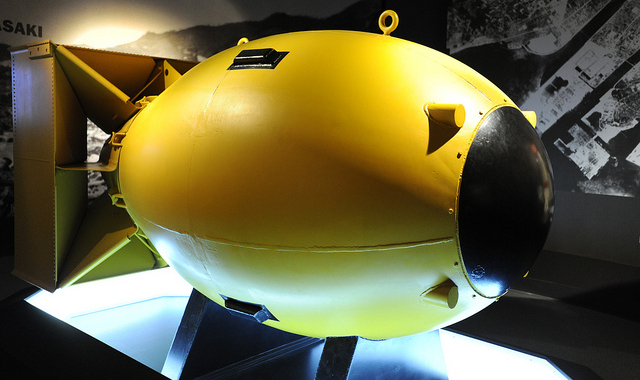
Welcome to Volume 3 of This Week In Tomorrow! It’s officially been two years that we’ve been bringing you the best in science, technology, skepticism, feminism, and futurism. Thanks for reading, and thanks in advance for continuing to do so. There’s a lot to get to this week, from a potential Android-Chrome merger, to anti-cancer viruses, to the largest nuclear detonation ever — so without further ado, let’s get to it. Read on.
***

ChromeOS and Android
This week we discovered that Google’s Chrome operating system and Android will be… something. That something is still up in the air though. The first reports, earlier this week, started off by saying that ChromeOS would be discontinued, and folded into Android by 2017. This makes sense, as both are Linux-derived and offer complimentary functionality. But then came the updates, which said, for example, that “a Google spokesperson has confirmed […] that both Chrome OS and Android will continue to exist; Chrome OS is not being “killed.” PC World has an anonymous source suggesting that both Android and ChromeOS will continue to be options, but that Google will be releasing a “third way” that combines elements of the two. It remains to be see exactly what’ll take place, but as far as many are concerned, it was only a matter of time before some form of Google-backed Linux started competing more directly with OSX and Windows. Linux only has about a percent and a half of the desktop OS market share right now, but with Android taking over fifty percent of the mobile market (and the opportunities for cross-platform continuities looming) let’s just say Windows and Apple might want to keep an eye on the rear-view mirror.
In other Google news, Project Loon is shaping up to run a full-scale test in 2016, with a ring of at least 300 internet-providing balloons to circle the world providing internet access to, well, at least the people of Indonesia. Google says, among other things, the balloons have now lasted as long as 187 days, and take only three people and fifteen minutes to launch. It’s a strange, balloony future we’ve got coming. BBC has more.

Anti-Cancer Viruses
The FDA just approved the first in a new class of cancer-fighting weapons this week: called Imlygic, the “drug” (if it’s even appropriate to call it that: technically the term is “oncolytic viral therapy”) is actually a live virus that kills cancer cells. It’s not terribly effective — according to Wired “in trials it extended [metastatic melanoma patients’] survival time by 4.4 months and shrunk tumors for at least six months in 16 percent of patients” — and they’re still not sure if the virus is killing the cancer cells much itself, or if it’s signalling to the immune system that something is going on in the area of the tumour and that something ought to be done. But it’s likely to provide an economic incentive for more research in the nascent field, which could help drive the production of more, and more effective, cancer-fighting viruses. Check out the press release from the manufacturer Amgen, and the analysis from Wired and Forbes for more.

Green Energy Goes Big
The first stage of what will likely be the world’s largest concentrated solar power plant is about to go live. Noor 1, the first stage of the Ouarzazate solar power plant under construction in Morocco, will generate a peak capacity of 125-160MW, and, using a molten salt reservoir, will be able to provide electricity up to two hours after the sun has set. Noor 2 and 3, set for ultimate completion in 2017, will up the peak power output to 580MW and the after-hours duration to eight hours. Morocco plans to produce 50% of its power from renewables by 2020.
In other news, the UK has okayed plans by DONG energy to build the world’s largest offshore wind plant 19km off the coast of Cumbria. The 660MW peak-power Wanley Extension project will surpass DONG energy’s other project, the 630MW London Array, when it opens in 2018. Engadget has more on that story.

Investing for All?
The US Securities and Exchange Commission has just relaxed its rules for investment to encourage lower-income Americans to invest in startups through crowdfunding campaigns. Previously, investors were required to be “accredited,” which is to say, “rich”: investors in non-publicly-traded companies were required to have either over $1,000,000 in net worth or an annual income of over $200,000. Under the new rules, which will go into effect in roughly six months, will allow individuals earning under $100,000 a year to invest whichever is higher: 5% of the lesser of their annual income or net worth, or, $2000. The new rules clear up a sticky situation for crowdfunders, which typically rely on many small investments, rather than those after typical venture capital, which rely on large cash injections by major VC firms. It’s also important to note that both sets of rules, old and new, are designed to protect investors from themselves: investing too much of your income in any startup is only a step above gambling, and as Kickstarter has often proven, it’s “buyer beware” every time. Check out the SEC ruling or Gizmodo for more.
ICYMI
In case you missed any of the last stories of Volume 2, here are some links. Check them out if you haven’t yet:
- Monday: The Wishing Machine (100% Snake Oil)
- Tuesday: The WHO and Carcinogenic Meat (a possibly over-skeptical analysis)
- Wednesday: Future Power 2: The Stellarator (a new/old kind of nuclear fusion)
- Thursday: Your Anti-Vaccine Fantasies are Insulting and Hurtful, and Here’s Why (a rant)
- Friday: Solomon, That’s Called Rape (a post on marital rape)
Best of the Rest
And because there’s always more to cover than I can in one post, here’s more linkspam to get you through the week:
- Scientists have made a sound-based tractor beam
- Northrop-Grummon have won the contract for the US’s next stealth bomber
- The Wayback Machine is getting a search function at last
- Yamaha has made a motorcycle-riding robot
- The DMCA exemptions have expanded a little, and now include blu-ray disks
- Japanese scientists have made a glass that’s 50% alumina and very, very strong
And to leave you for the week, here’s a video on the Tsar Bomba: the largest nuclear warhead ever detonated. The 50-Megaton bomb was detonated on October 30, 1961, making this past Friday the 45th anniversary. Happy Tsar Bomba day, everyone.
Don’t forget to like the page on Facebook and follow me on Twitter, and have a great week.
